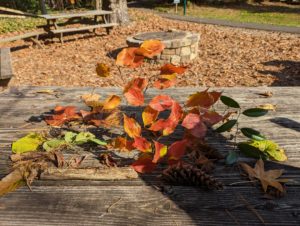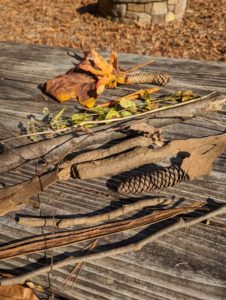Practices
How Nature Heals
When we are outside in Nature, it is easier to be present with our surroundings, i.e. in the present, than when we are indoors in our own heads. Why is that? As Robin Wall Kimmerer says in Braiding Sweetgrass, our senses “are muted within four walls, where my attention would be on me instead of all that is more than me (p. 295).” When we are out in Nature, we are drawn to things we find beautiful or intriguing. Our curiosity grows. We wonder about things greater than ourselves. As we engage with our surroundings and the beings we encounter, it gives the thinking part of our brains a rest, the part of our brains that worries and replays our difficult situations, and tries so hard to find resolution to seemingly unsolvable problems. Something happens, however, when we are able to let go of this worry, to let it loosen by letting our attention wander elsewhere. Our perspective shifts without our doing the work. We may find we suddenly have a new way of looking at our troubling situation, or the energy of our worry has dissipated. We gain a bit more clarity. Our mind is able to rest.

The following Mindfulness in Nature practices are described below:
- Meditations
- Mindful Slow Walking
- Sit Spot/Ask a Tree a Question
- Using Our Senses
- Group Observation of a Tree
- Nature Collection and Art Experience
———
Mindfulness in Nature Meditations
The Mindfulness in Nature meditations are characteristic of guided sitting meditation as presented in the Mindfulness-Based Stress Reduction course. However, these meditations have nature imagery interwoven throughout, helping the person practicing to feel the nourishment of the forest or the support from the Earth or calmness of the waves, for example. These meditations can be practiced indoors or outdoors, but become even more meaningful if practiced in a natural setting. There are options for listening to the meditations with or without Native American flute music in the background. The meditations are adapted from a combination of sources, including meditations by Corine Caffort and Dave Potter of Palouse Mindfulness, and Diana Winston of the UCLA Mindful Awareness Research Center. The meditations include a meditation for Beginners, one focused on Awareness of Thoughts, one focused on Feeling One’s Emotions, and one focused on Self-Compassion. Enjoy!
Click here to access the Meditations.
———-
Mindful Slow Walking in Nature
A Mindful, slow walk can be done anywhere there is a small patch of “Nature” – from flowers planted or growing along an urban street to a pathway in the woods or along a creek. This type of walk can be done individually or with a group. If in a group, it is suggested to participate silently and keep a space of about 6 feet between participants. Try to walk a quarter of one’s normal pace – very slowly! Like sitting meditation, a Mindful slow walk can have an anchor that is the focus that you continually return to. Some suggested anchors are “Observe anything that moves” or “Observe anything that is not green” or “Focus on the sounds in your surroundings.” Notice how your mind wanders as you are walking, and when you notice it wandering, gently return to observing your surroundings. It is important to note that focusing on an anchor is only an invitation. On every Mindful walk, individual participants are encouraged to follow the invitation only if it speaks to them that day; instead, a person may need to let their mind freely observe instead, or have another individual need. Participants are encouraged to pay attention to their own needs.
———–
Sit Spot/Ask a Tree a Question
- Nature Observation – One of the ways we can observe Nature in the greatest depth is by literally finding a place to sit in Nature for an extended period of time (at a minimum 5-10 minutes). When we find stillness, the wildlife who are often chased away when we are walking or making noise, begin to come back. Sitting in Nature is rarely boring, as you will notice how it is constantly in flux – whether you are observing the geese in the nearby creek or the insects getting nectar from flowers or ants marching in what appear to be invisible lanes carrying many times their weight across great distances, and on and on.
 You may also notice the wind in the trees, and if you listen carefully, the wind or the creek or one of the creatures may be bringing a message for you. In Native American traditions and many other cultures, it is common that certain animals or other creatures bring with them a Message for the observer. For example, a Great Blue Heron may visit you with a message about Solitude and Self-Reliance. Or a Woodpecker may visit you with a message about Persistence, and the importance of not giving up on a difficult task. Praying Mantis reminds us of the importance of Stillness, as we learn to observe and listen to the Nature around us.
You may also notice the wind in the trees, and if you listen carefully, the wind or the creek or one of the creatures may be bringing a message for you. In Native American traditions and many other cultures, it is common that certain animals or other creatures bring with them a Message for the observer. For example, a Great Blue Heron may visit you with a message about Solitude and Self-Reliance. Or a Woodpecker may visit you with a message about Persistence, and the importance of not giving up on a difficult task. Praying Mantis reminds us of the importance of Stillness, as we learn to observe and listen to the Nature around us. - Ask a Tree or the Forest a Question -Many people seek out Nature when they are having difficulties in their life, and it is amazing the wisdom that one can receive from Nature if one is willing simply to ask a question and listen for the answer. There is an age-old tradition of Asking a Question of a Wise, Old Tree or the Forest in general. When one tries this practice, they are often surprised by the wisdom they receive.
- Sit Spot – As part of an Eco-Mindfulness or Mindfulness in Nature class, participants may be given 10-15 minutes to find a Sit Spot that is calling to them. This activity can be combined with the 5 Senses Grounding Activity below to help participants connect with Nature through their senses, or participants may be invited to simply observe or ask a question of a Tree or the Forest or connect in their own way, such as through journaling or drawing or photography.
———-
Using our Senses
One of the main ways that Mindfulness can help us connect with the present moment is through a focus on our senses. When we are intentionally using our senses to observe our surroundings, it is literally not possible for us to be ruminating in our own minds about our worries of the day. Try it for yourself. As soon as you start listening, for example, to sounds around you, your mind focuses on that, and takes a break from other thoughts. Many activities that involve intentionally using our senses are called Grounding activities because they help us get “out of our heads” and focus on the present. One specific activity that can be used in Nature or any other setting (such as a doctor’s waiting room!) to help calm the mind is the 5 Senses Grounding Activity. In order to engage in this activity, simply observe:
- 5 Things you can see
- 4 Things you can feel/touch
- 3 Things you can hear
- 2 Things you can smell
- 1 Thing you can taste (optional)
This Mindful in Nature Scavenger Hunt (add link) helps participants practice the above activity, as well as come into the present by looking and listening for different entities (creatures, objects, etc) in your natural surroundings. As you engage in this activity, notice how when you become focused on a particular task in the present, the worries of the day tend to fade away (at least temporarily), and it gives that part of your mind a break. This activity can be done individually or with a partner as part of a class, and can be modified for students of any age.
———–
Group Observation of a Tree
Ever go on a walk or hike with a Naturalist and wonder how they know how to identify various trees or flowers? While many of us may enjoy going on this type of walk, what if you could learn to observe trees or flowers yourself, so that you can connect with them on your own? This activity is meant to be done as part of a group, as practice for developing one’s own observation skills. For this activity, the instructor should pick a tree that has easily identifiable features (leaves/needles, bark, cones or seed pods, flowers depending on the season, root structures, etc). Participants are then given 5-10 minutes to observe the tree with as many senses as possible; they are encouraged to connect with the tree through touch and smell, in addition to observing with one’s eyes. After the observation time is over, ask participants one by one to share an observation about the tree. Participants can then hear all the different ways that other classmates have made observations, perhaps ways they would not have thought of on their own.
The following two poems came from group observations during the Mindfulness in Nature class:
———–
Nature Collection and Art Experience
For this activity, participants are invited to go on a Mindful slow walk and collect small items that catch their attention or speak to them in some way (leaves, twigs, flowers, pine cones, etc). It is helpful to carry a bag to collect these items. After 10 minutes or so of collection time, participants are invited back to an area that has a flat surface, such as a table or bench, or even a flat rock or the ground will work. The invitation is to create a piece of art from their Nature items that conveys some kind of message either to themselves or to others in the group. For example, a participant might use a rock to convey a strong foundation, while grasses or flowers may convey growth based on that strong foundation. After 5-10 minutes of creation time, participants are invited one by one to present their work of art to the group and share its message.
Summer Art




Fall Art



